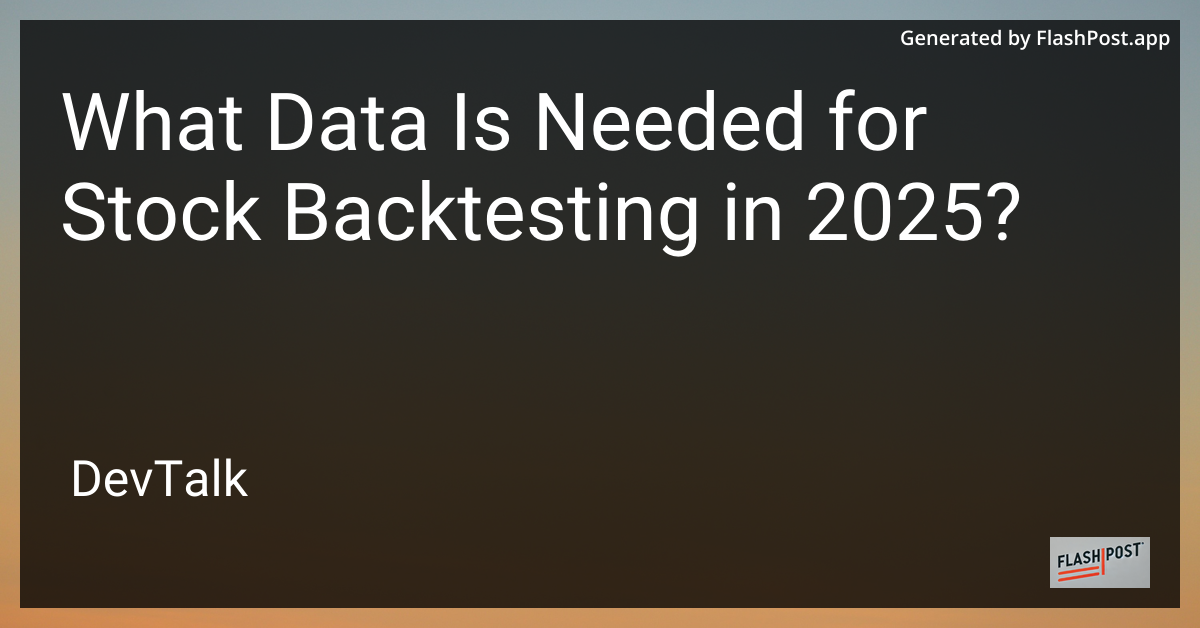What Data Is Needed for Stock Backtesting in 2025?
 # What Data is Needed for Stock Backtesting in 2025?
# What Data is Needed for Stock Backtesting in 2025?
Backtesting is an essential component of developing successful trading strategies.
As we approach 2025, traders and analysts are increasingly focusing on leveraging advanced data sets to craft strategies that stand the test of time. This article will explore the crucial data necessary for stock backtesting in the year 2025, ensuring your strategies are optimized for future market conditions.
Key Data Requirements for Stock Backtesting
1. Historical Price Data
Historical price data forms the foundation of any backtesting process. It includes:
- Open, High, Low, Close (OHLC) values: Crucial for analyzing past price behaviors.
- Volume data: Provides insight into the significance of price movements.
With advancements in data technology, accessing granular historical price data, even at the tick level, has become more accessible, enhancing the accuracy of backtesting.
2. Corporate Actions and Events
Corporate actions like stock splits, dividends, and mergers can significantly impact stock prices. In 2025, it is vital to integrate this data to adjust historical prices accurately and test strategies against these anomalies.
3. Economic Indicators
Economic indicators such as GDP growth rates, interest rates, and employment data provide context to market movements. For effective backtesting in 2025, incorporating these indicators can help in understanding macroeconomic influences on stock performance.
4. Alternative Data
The use of alternative data is rapidly gaining traction. It includes:
- Social media sentiment: Gauges investor sentiment through platforms like Twitter and Reddit.
- News analytics: Real-time processing of news to assess its impact on stock prices.
- Geolocation data: Tracks foot traffic and retail sales trends.
Including alternative data in your backtesting regime will provide a competitive edge in identifying hidden patterns and trends.
5. Real-Time Data Feeds
Although generally used for live trading, incorporating near-real-time data feeds into backtesting platforms can simulate market conditions more accurately. It helps in stress-testing strategies under different market scenarios, enhancing their robustness.
6. High-Frequency Data Analysis
With the growth of algorithmic trading, high-frequency data analysis has become critical. It involves second-by-second or even millisecond-by-millisecond trade data, allowing strategies to be tested for their efficiency and reliability under ultra-fast market conditions.
Enhancing Your Backtesting Strategy
Understanding and gathering the right data is only part of the equation. Improving stock backtesting with real-time data can significantly enhance the accuracy and reliability of trading strategies.
For more information on integrating these data types into your stock backtesting process, explore relevant resources like trading strategy backtesting and how to backtest trading strategies for accuracy.
Conclusion
In 2025, the continuous evolution of financial markets demands more sophisticated data sets and tools for backtesting. By integrating historical price movements, corporate actions, economic indicators, alternative data, real-time data feeds, and high-frequency analysis, traders can significantly enhance their strategy development process. Staying ahead in the world of stock trading means being adaptive and leveraging every available data point to its fullest potential.